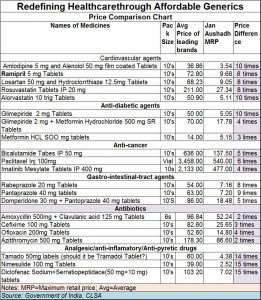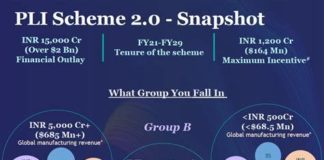http://www.freepressjournal.in/analysis/jan-aushadhi-could-disrupt-domestic-pharma-market/1148447
Jan Aushadhi could be a game changer for Indian pharma
— By | Oct 05, 2017 08:16 am
This is like many other schemes that the previous government merely talked about, introduced, and then forgot. The Jan Aushadhi (literally translated as medicine for the people) is one for which the current government should be lauded. It could actually shake up the world of medicare. It has the potential to disrupt the $15 billion market for pharmaceutical products in the country.
 It was started in 2008 to provide quality generic drugs at affordable prices. As the adjoining table shows, the shops selling such drugs offer them at prices that are cheaper by at least 2 times to as much as (hold your breath) 14 times when compared against the prices quoted for the respective leading brand in India.
It was started in 2008 to provide quality generic drugs at affordable prices. As the adjoining table shows, the shops selling such drugs offer them at prices that are cheaper by at least 2 times to as much as (hold your breath) 14 times when compared against the prices quoted for the respective leading brand in India.
Wonder scheme
According to a brilliant report by CLSA (http://www.asiaconverge.com/wp-content/uploads/2017/10/2017-10-05_CLSA-Healthcare.pdf) brought out in August 2017, it talks about the amazing achievements of this scheme. This is something the government should be crowing about more aggressively. It is intriguing that very few people, including doctors, know anything about it, and the good work being done on this front.
CLSA’s recent visit to one such Jan Aushadhi store in Mumbai suggests increasing acceptance for this scheme (300 prescriptions daily). If the model scales up and there is a shift from brands towards generics, then it could be a cause of concern for many major India-focussed pharma players.
India is unlike developed countries, where much of the pharma market is funded by insurance companies. Here, public health care system has collapsed. Medical insurance penetration is scant. Expenses relating to diagnostic, dental and geriatric care often excluded from most insurance schemes.
That is the reason why any move to make critical medicines available to the common man at cheaper prices is an immensely welcome step. It could also help clean up the oft-reported practice of doctors getting a ‘kickback’ from pharma companies once they prescribe their high-priced drugs.
At the same time, it could presage similar moves towards regulating prices of other critical health related equipment and services. The markets have already witnessed one such move being made where cardiac stents are concerned. Combine the twin moves of regulating stent prices and introducing generics at affordable prices, and you have the beginnings of a healthcare movement that could spread like wildfire.
Modus operandi
All generic medicines are sought to be sold through franchised retail outlets known as Pradhan Mantri Bhartiya Jan Aushadhi Kendras (PMBJKs or the Prime Minister’s medical outlets for people).
Public sector companies have been mandated to procure drugs only from WHO (World Health Organisation) and GMP (good manufacturing practices) compliant companies. This – as the CLSA survey points out — is done at the central level after performing adequate quality checks. These drugs are then sent to distributors in the various states. The distributors then supply the drugs to franchised PMBJK stores which are guaranteed a fixed 20% margin on sales. Today, Jan Aushadhi has a list of over 600 medicines (chronic and acute) and 150 consumables.
The plan is to have around 3,000 PMBJK stores by the end of 2017. Currently there are 2,091 such stores covering 400 (of the country’s 630) districts. The idea is to cover each of the tehsils (administrative blocks) that dot the country.
CLSA states that the plan suffered by supply side constraints initially. But, these appear to have been overcome. It is also hoped that the recently introduced GST regime will lead to seamless transport of medicines across states thus partially addressing the supply-side constraints.
The big question that gives pharma companies the jitters is whether the Jan Aushadi model can be a threat to existing, established pharma practices. Well, say medicare experts, that would depend on three factors:
(a) the number of products that the PMBJK centres would offer. That would let pharma companies decide on the products they would like to focus on, leaving the Jan Aushadhi products out of their range of activities. If the number of products is extremely large, it could squeeze out many pharma players out of this sector altogether.
(b) the ability of the government to create more suppliers for this scheme. But that will also depend on the guarantees the government gives for both timely payment and specified minimum offtake. Nobody likes a government that reneges on contracts. If the terms and the guarantees are attractive, there should be no dearth of suppliers.
(c) easy accessibility to such outlets. There is no sense having a retail outlet in Borivali (which is the case in Mumbai) when the patient lives in or around Parel.
Global possibility
There is a silver lining too. It could help India create a few giant pharma producers in a market that is fragmented by high-priced producers. There is also a huge market for clandestine sale of pharma products from low cost countries like India. A good example is anti-cancer drugs, which cost ten times more in China than they do in India. Even at current prices, there is a steady flow of anti-cancer drugs to neighbouring countries where they can be sold at higher prices. When Jan Aushadhi ushers in these drugs at one-fourth the current prices, expect the profit margins for such clandestine sales could become bigger.
But that could be good for India. If Indian pharma producers can sell larger quantities at one-fourth the current prices, and still make money from such distribution, they should not worry about margins others make. If Jan Aushadhi can guarantee quality, consistency and assured supply, it can even make India the global hub for – and the largest exporter of — pharma products.





































COMMENTS